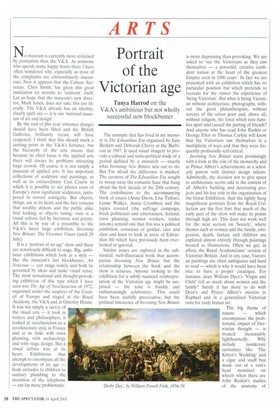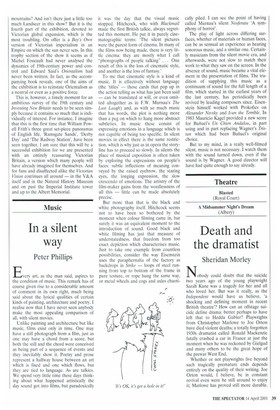Portrait of the Victorian age
Tanya Harrod on the V&A's ambitious but not wholly successful new blockbuster No museum is currently more criticised by journalists than the V&A. As someone who spends many happy hours there I have often wondered why, especially as most of the complaints are extraordinarily inaccurate. Now it appears that the Culture Secretary, Chris Smith, has given this great institution six months to 'reinvent' itself. Let us hope that the museum's new director, Mark Jones, does not take this too literally. The V&A already has an identity, clearly spelt out — it is our 'national museum of art and design'.
By the end of this year entrance charges should have been lifted and the British Galleries, brilliantly recast, will have reopened. I think that this should mark a turning point in the V&A's fortunes, but the hierarchy of the arts means that because its chief focus is the applied arts there will always be problems attracting huge crowds. Of course it is not simply a museum of applied arts. It has important collections of sculpture and paintings, as well as its extraordinary Cast Courts in which it is possible to see plaster casts of Europe's most significant sculptures, juxtaposed in surreal contiguity. But objects, things, are at its heart and the fact remains that wealthy donors and the public alike find looking at objects taxing: ours is a visual culture fed by literature and poetry. All this is by way of a preamble to the V&A's latest large exhibition, Inventing New Britain: The Victorian Vision (until 29 July).
It is a 'portrait of an age' show and these are notoriously difficult to stage. Big, ambitious exhibitions which look at a style — like the museum's last blockbuster, Art Nouveau — can range widely and both be governed by ideas and make visual sense. The most sensational and thought-provoking exhibition of this type which I have seen was The Age of Neoclassicism of 1972, organised under the auspices of the Council of Europe and staged at the Royal Academy, the V&A and at Osterley House. It was not simply a survey of the visual arts — it took in writers and philosophers, it looked at neoclassicism as a revolutionary style in France and at its links with town planning, with archaeology and with stage design. But a visual debate was at its heart. Exhibitions that attempt to encompass all the developments of an age — from attitudes to children to sanitary plumbing to the invention of the telephone — are far more problematic. The example that has lived in my memory is The Edwardian Era organised by Jane Beckett and Deborah Cherry at the Barbican in 1987. It used visual imagery to provide a cultural and socio-political study of a period defined by a monarch — exactly what Inventing New Britain sets out to do. But I'm afraid the difference is marked. The curators of The Edwardian Era sought to sweep away the romantic haze that hung about the first decade of the 20th century. The contributors to the accompanying book of essays (Anna Davin, Lisa Tickner, Lynne Walker, Annie Coombes) and the topics covered (the suffrage campaign, black politicians and entertainers, Ireland, town planning, women workers, trades unions) remind one that this was a political exhibition, conscious of gender, race and class and keen to look at areas of Edwardian life which have previously been overlooked or ignored.
Similar issues are explored in the substantial, well-illustrated book that accompanies Inventing New Britain but the relationship between the book and the show is tenuous. Anyone looking to the exhibition for a subtly nuanced reinterpretation of the Victorian age might be surprised — the tone is frankly and embarrassingly celebratory. This could have been usefully provocative, but the political innocence of Inventing Nell Britain is more depressing than provoking. We are asked to 'see the Victorians as they saw themselves — a powerful, creative confident nation at the heart of the greatest Empire seen in 1000 years'. In fact we are presented with an exhibition which has no particular position but which pretends to recreate for the viewer the experience of 'being Victorian'. But what is being Victorian without architecture, photography, without the great philanthropists, without surveys of the urban poor and, above all, without religion, the force which tore families apart and caused the parting of friends? And anyone who has read John Ruskin or George Eliot or Thomas Carlyle will know that the Victorians saw themselves in a multiplicity of ways and that they were frequently profoundly self-critical.
Inventing New Britain starts promisingly with a look at the role of the monarchy and at Prince Albert's achievements as a scholarly patron with distinct design talents. Admittedly, the decision not to give space to architecture seems odd in the context of all Albert's building and decorating projects and his key role in the organisation of the Great Exhibition. And the tightly hung magnificent portraits from the Royal Collection are the first hint that much of the early part of the show will make its points through high art. This does not work well for the next section on 'Society', where themes such as women and the family, emigration, death, fantasy and children are explored almost entirely through paintings treated as illustrations. Often we get, in effect, the Royal Academicians' version of Victorian Britain. And in any case, Victorian paintings are often ambiguous and hard to read — which is why it would have been nice to have a proper catalogue. For instance, does William Dyce's 'Virgin and Child' tell us much about women and the family? Surely it has more to do with Dyce's and Prince Albert's interest in Raphael and in a generalised Victorian taste for early Italian art.
The big theme of nature — which encompasses the problematic impact of Darwinian thought — is treated inexcusably lightheartedly. Why include taxidermic curiosities like 'The Kitten's Wedding' and a cigar and snuff box made out of a ram's head mounted on wheels when there are John Ruskin's studies of the anatomy of
mountains? And isn't there just a little too much Landseer in this show? But it is the fourth part of the exhibition, devoted to Victorian global expansion, which is the most troubling. On offer is a Boy's Own version of Victorian imperialism in an Empire on which the sun never sets. In this trophy section of the show it seems as if Michel Foucault had never analysed the dynamics of 19th-century power and control and Edward Said's Orientalism had never been written. In fact, as the accompanying book reveals, one of the aims of the exhibition is to reinstate Orientalism as a neutral or even as a positive force.
This is, however, a timely moment for an ambitious survey of the 19th century and Inventing New Britain needs to be seen simply because it contains so much that is individually of interest. For instance, I imagine that this is the first time that William Powell Frith's three great set-piece panoramas of English life, 'Ramsgate Sands', 'Derby Day' and 'The Railway Station', have been seen together. I am sure that this will be a successful exhibition for we are presented with an entirely reassuring Victorian Britain, a version which many people will have already imagined for themselves. And for fans and disaffected alike the Victorian Vision continues all around — in the V&A itself and in the Natural History Museum and on past the Imperial Institute tower and up to the Albert Memorial.



























































 Previous page
Previous page